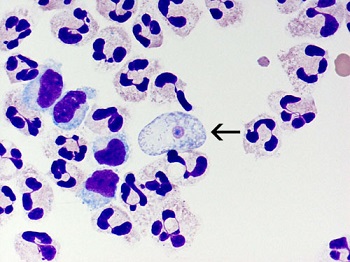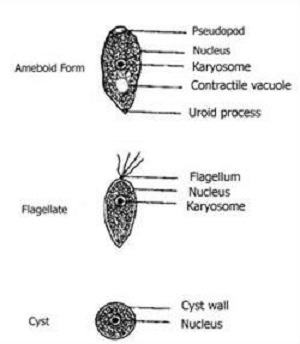Naegleria fowleri - Classification, History, Habitat, Morphology, Culture
Introduction of Naegleria fowleri
Naegleria fowleri is a free-living amoeba found in the soil, sewage, and water which causes infection of the Central Nervous System (CNS) and is mostly fatal. It causes primary amoebic meningoencephalitis (PAM) which is an acute, fulminant, rapid, and fatal infection of the central nervous system.
Classification of Naegleria fowleri
The classification of Naegleria fowleri is phenotypic as follows:
Domain: Eukaryota
Phylum: Percolozoa
Class: Heterolobosea
Order: Schizopyrenida
Family: Vahlkampfiidae
Genus: Naegleria
Species: N. fowleri
History of Naegleria fowleri
Historically, in 1965, Malcolm Fowler and Rodney F Carter first described Naegleria fowleri from South Australia. Bull coined the term primary amoebic meningoencephalitis in 1966 to distinguish this condition from secondary meningoencephalitis caused by Entamoeba histolytica.
Habitat of Naegleria fowleri
Naegleria fowleri is free-living amoebae that inhabit the soil, fresh as well as brackish water such as lakes, rivers, ponds, etc. They are also found in the throat and nasal cavities in humans.

Image: stained N. fowleri under microscope (Source: CDC)
Morphology of Naegleria fowleri
In its life cycle, Naegleria fowleri exists in three morphologically stages:
trophozoite
amoeboflagellate (temporary flagellar stage)
cyst
Trophozoites
vegetative stage/feeding stage of the Naegleria fowleri amoeba
trophozoites measure 10-20 μm in diameter
the presence of granular cytoplasm, distinct ectoplasm, and multiplies by binary fission
a characteristic feature is the presence of a large central nuclear karyosome surrounded by a halo
motility takes place with the help of labopodia
In addition to motility, the broadly rounded, granule-free Labopodia projection originating from the surface of the amoebae also helps in the ingestion of bacteria, yeast cells, and cellular debris as well as in attachment
in host tissue, it ingests red and white blood cells which results in the destruction of the host tissue
found in CSF or in the tissue
Flagellate stage
this flagellate stage is called the amoeboflagellate stage which is a temporary, non-feeding, and non-dividing form
formed when the Naegleria fowleri trophozoites are introduced to a change in ionic concentration including the distilled water
this form usually occurs within 2 hours of exposure and can revert back to trophozoite form within 24 hours
pear-shaped with a flagellar apparatus at the broader end containing two terminal flagella, two basal bodies, microtubules, and a single striated rootlet called rhizoplast
movement at this stage is a rapid forward movement or a slow-spinning circular motion
Cyst
this form is the resistant form which protects Naegleria fowleri from drugs, desiccation as well as shortage of food
round, 7-10 μm in diameter enveloped in a smooth double-layered 1 μm cyst wall
contains a single nucleus, contractile vacuoles, and food vacuoles
in clinical specimens, cysts are not usually observed as the rapid infection results in quick death- before trophozoites are able to encyst
when environmental conditions are favorable, they excyst to their trophozoite form

Fig: N. fowleri morphological forms (Source: ResearchGate)
Culture of Naegleria fowleri
Naegleria fowleri can be cultured in media as in laboratory animals.
In media
Non-nutrient agar inoculated with monoxenic culture of bacteria such as Enterobacter species and Escherichia coli
Axenic culture for Naegleria fowleri – enriched broth without added bacteria
monolayer cell lines cultures such as Hela cells, MRChuan embryonic lung cells, and monkey kidney cells
In laboratory animals
laboratory animals such as rabbits, rodents, and sheep can be used for experimental infection
South American tapir is naturally susceptible to infection by Naegleria fowleri